Table of Contents
Best Trees for a Large Garden
For many of us, gardening is a well-loved hobby. For others, it’s a bit of a burden and something that just needs to “get done.”
Regardless of where you fall in that spectrum, planting trees can be a bit more challenging than some of the other types of gardening because of their size, their cost, and the fact that the results aren’t usually seen as quickly as with flowering plants, shrubs or ornamental foliage.
Trees are oftentimes chosen for a garden in order to serve a purpose. Many times, that purpose is to provide privacy from neighbors or traffic passing by.
Other times, trees are used to give some needed shade, attract birds or animals, or just to add some aesthetic value to your home.
Regardless of why you are planting them, trees are good for the environment and our soul. The joy that trees will bring you is well worth your time and treasure, especially if you choose wisely and find trees that will work well with your yard’s conditions and your ability to care for them correctly.
Let’s look at some of the best trees for large gardens and find out why these make my list.
1. Sugar Maple Tree
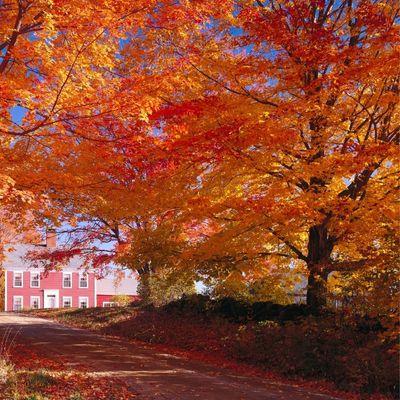
Sugar Maple Tree
One of the favorites of any large garden is the Sugar Maple Tree. If you are lucky enough to have the room for one of these majestic beauties, then it’s a top contender for one of the best trees in the large garden department.
Sugar Maple Trees can grow to be 40 to 60 feet tall! Don’t worry, though – all that growth will take some time, as a typical Sugar Maple grows about 2 to 3 feet per year.
Sugar Maples get their name from the glorious sweet sap that is inside their trunks. Many people choose to use the sap to make maple syrup, but you can also just enjoy the tree without ever deciding to remove the sap from it, especially if your tree is young since it takes about 30 years of growth before the sap is ready to be tapped.
Sugar Maple trees need full sun, but since they are so large, they will usually not struggle to get the sun needed to thrive. That said, make sure you plant yours in a spot where it won’t struggle for sunlight while it’s young.
Though these trees will grow to a large height, they will take time to get there. The glorious golden show they give in the fall will be well worth it if you have the patience and space to plant a Sugar Maple in your yard or garden.
2. Red Oak Tree
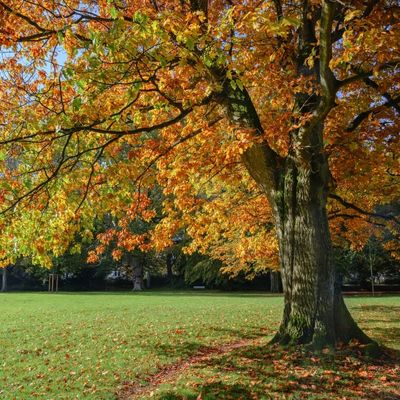
Red Oak Tree
Another grand, glorious favorite is the Red Oak tree. Like the Sugar Maple, these trees will take time to grow, but if you have the patience, they will be well worth it.
Red Oak trees will be around 75 feet tall when they reach their full height, so this is truly a tree that should only be grown in gardens that are large enough to accommodate such a specimen. But if your area can handle it, the Red Oak majesty is a sight to see and the colors these trees produce in the fall are absolutely stunning.
For such a large tree, the Red Oak is actually quite easy to grow and care for. They prefer cooler climates, so many of the healthier Red Oak is seen in the Northeast of the United States where the winters are cold and the hardy Red Oak thrives best.
Red Oaks need lots of sunlight to grow and once they are established, they won’t struggle to get it, like the Sugar Maple I discussed earlier. Make sure your Red Oak is planted in soil that is somewhat sandy and drains well. Though they are very drought-resistant, it’s important you water them well the first few years after they are planted, and they will provide you with plenty of beauty and joy for many years to come.
3. Green Giant Arborvitae Tree
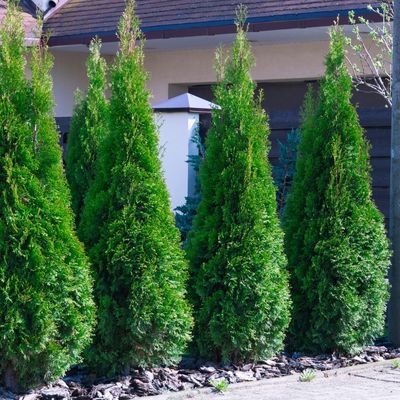
Green Giant Arborvitae Tree
Switching gears a bit, another great grower that is more ideal for privacy is the Green Giant Arborvitae, a popular plant amongst people who are really looking to build a strong privacy wall with their greenery.
The Green Giant is exactly what its name implies – giant and green.
A popular choice for people who want privacy, and want it fast, the Green Giant Arborvitae is an evergreen that will keep its color all year long, and can grow as much as three feet in one year.
Arborvitae means “tree of life”, and this big beauty certainly brings a lot of that to your yard. People with big gardens who want ample private space will love the solitude this tree brings to a yard and the ease at which it grows.
The Green Giant Arborvitae grows in a cone-like shape and its dark green foliage will stay consistently green throughout the year, darkening a bit in the winter months.
Though it will grow best in full sun, the Green Giant Arborvitae can withstand some shade. Just make sure to plant it in an area where it will receive at least 4 hours of sunlight per day.
It also prefers soil that is well-drained, but can tolerate a decent variety of soil types.
The Green Giant Arborvitae isn’t as showy as the Red Oak or Sugar Maple are in the fall, but its consistent color and great growth ability make it an excellent choice for those larger gardens that really need trees to serve as a way of providing more privacy and property boundary lines.
4. Magnolia Tree
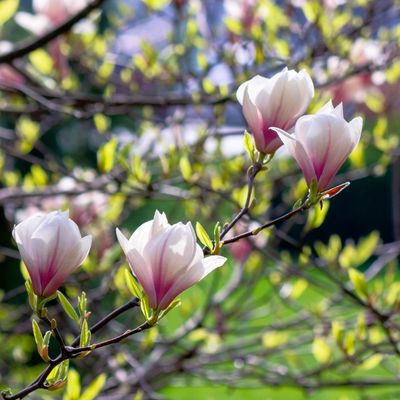
Magnolia Tree
One of the sweethearts of the South is the Magnolia tree, and for very good reason, especially for those who have a large space to fill.
Magnolia Trees are known for their gorgeous white flowers and fantastic fragrance that usually begins mid-Spring, depending on where they are planted. They also have dark green, glossy leaves that will stay green all year, especially in warmer climates.
They also produce reddish berries in the fall that add to their attractive diversity and appeal, for us as well as the wildlife in your yard!
Magnolia trees can grow to be as tall as 50 feet, and will take up a fair amount of your yard or garden, as their limbs are thick and wide. A Magnolia can add great beauty to any landscape, but the more space you have, the better for these fast growers.
These trees have a big advantage over some of the others on my list for anyone who has a garden that tends to stay wet. Magnolia trees like soggy soil and do very well in areas that hold water, or where rain is frequent.
Magnolia trees won’t do well in colder climates, which is why they are such a trademark of the South. They also will need at least 6 to 8 hours of direct sunlight each day, so make sure they are planted somewhere away from shade, especially if you want bigger and more beautiful flowers to result.
5. Holly Tree
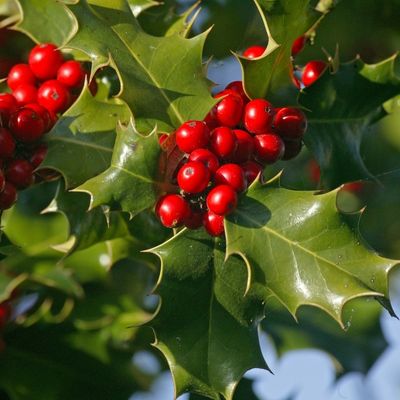
Holly Tree
The Holly tree is another favorite amongst gardeners who want something that can grow large and provide plenty of showiness in the winter months as well as summer ones.
The Holly is an evergreen and will continue to keep its showy green leaves all winter long. It also produces gorgeous red berries that are a favorite amongst birds and will keep them feeding in your garden throughout the cold winter months, giving your yard a sense of activity even when it’s cold outside and giving something back to the environment.
Just remember that, in order to have berries, you’ll need to have a male Holly tree nearby, preferably one male for every 5 female Holly trees.
Holly trees come in two main types – the English Holly, which produces the leaves that you see with white tips, almost like snow, and the American Holly, which has darker leaves and tends to grow much taller than the English Holly.
Though Holly trees come in an array of choices, caring for most of them is pretty straightforward, as these trees tend to be hardy, easy-to-maintain plants for almost any garden, especially one that is large and needs a fair amount of color and privacy.
Gardeners from most of the United States have been able to successfully grow Holly trees, though the deep South may stay too warm in the winter for it to produce much in the way of berries. Holly trees are happiest in climates where the temperatures cool off substantially in the colder months.
Holly trees will do best in well-drained soil, but they can withstand some wetter areas as well. Another big advantage to the Holly tree is that it doesn’t need any sort of regular fertilizer and placing a small amount of mulch around its base in the fall will give it the added protection it needs, without requiring anything further.
6. Dogwood Tree
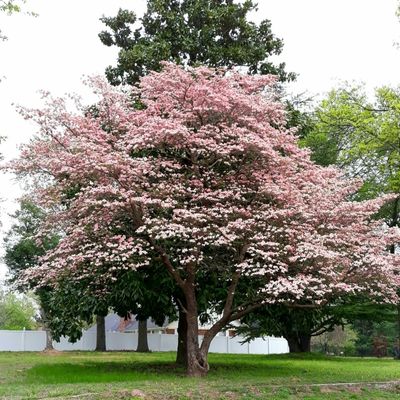
Dogwood Tree
Another big favorite amongst many gardeners around the United States is the Dogwood Tree,
One of the biggest and longest bloomers, the Dogwood Tree is a great specimen to have in your large garden for a number of reasons.
It has a long bloom season, starting in early spring and usually lasting through early summer, maybe longer in warmer climates. In the fall, its leaves are a striking addition to your landscape, then drop to reveal unique and aesthetically pleasing bark that in and of itself is a beauty to any garden.
A typical, healthy Dogwood tree will grow to an impressive height of 40 feet. It’s a medium grower, usually adding 12 to 20 inches in height per year, making it a wonderful addition to a large garden.
Dogwood trees don’t need a lot of special care, and are easily adaptable to a variety of climates. The one thing they do require is adequate water, so they may not do well in areas where water is a concern, unless you have the ability to water them frequently, or provide irrigation to these plants.
They also are not fond of wet, marshy areas, so any place that tends to stay boggy won’t be the best spot for your Dogwood.
Though pruning of the Dogwood isn’t necessary for its overall growth, if you are willing to cut back any dead branches in the later winter, the Dogwood will reward you by maintaining its unique, canopy-type shape well into the next season.
7. Bald Cypress Tree
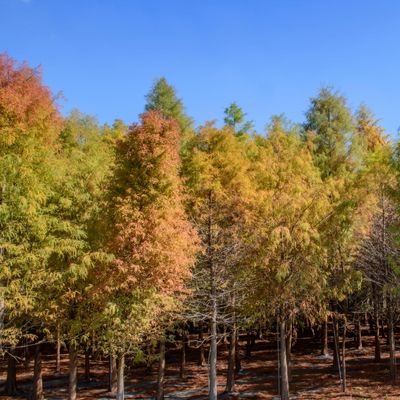
Bald Cypress Tree
On the other end of the spectrum from the Dogwood tree is the Bald Cypress tree, when it comes to soil conditions.
The Bald Cypress likes swampy, wet areas as much as the Dogwood can’t tolerate them. Think of planting a Bald Cypress if you have an area in your large garden that tends to stay wet, even during drier periods.
These trees were originally found in parts of the country like the Louisiana bayous, where the conditions are perfect for it.
Now, it is starting to be used in private gardens and urban settings as well, since its thick branches and large needles provide excellent shade and privacy for larger areas as well.
The tree's soft needles will stay green through summer, then turn to a lovely rust color before they fall in the colder months.
The Bald Cypress can grow as tall as 50 feet at maturity, making it a great choice for larger gardens. It is well-loved by many forms of wildlife and will attract ample birds to your yard.
Planting the Bald Cypress in full to partial sun will guarantee its growth. These trees don’t need much care, but will need plenty of watering if they are not planted in an area that stays moist much of the time.
Though the Bald Cypress doesn't produce flowers, it has a unique trunk that is fun to witness. Small knee-shaped knots form in various spots on the trunk, making this tree a definite conversation piece.
The Bald Cypress may not be the showiest tree in your yard, but if you’ve got those spots that won’t dry out, and you are looking for an easy, low-maintenance plant that will definitely be unique, consider the Bald Cypress for your large garden wet spaces.
8. Eastern White Pine Tree
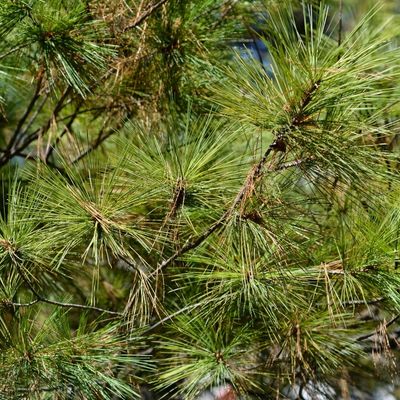
Eastern White Pine Tree
Finally, one of the best-known and most loved trees for large areas is the Eastern White Pine.
These majestic trees are well-known for their year-long greenery, fast growth, and easy-to-care for nature. Anyone who sees an Eastern White Pine will think of holidays, snow, and the cozy days of winter.
This is not a tree for a garden that doesn’t have space. The Eastern White Pine needs room, and if you have it to give, it will reward you for it through many decades to come.
These trees can grow up to 150 feet high and have a lifespan of over 200 years.
They are particularly fond of the climate in the eastern part of the United States, as they prefer cooler winters and a bit of humidity in the summer months.
Because of their height and impressive width, Eastern White Pines will make an excellent source of privacy for someone with a large garden or landscape area to fill. Their cone-like shape makes for great ornamental trees and reminds us of Christmas and winter holidays.
The Eastern White Pine has thin needles that provide a great source of mulch for the tree when they fall.
The maintenance of these trees is very limited, as long as they have at least 6 hours of sunlight a day, moderate water, and soil that is well-drained.
Recent Articles

















